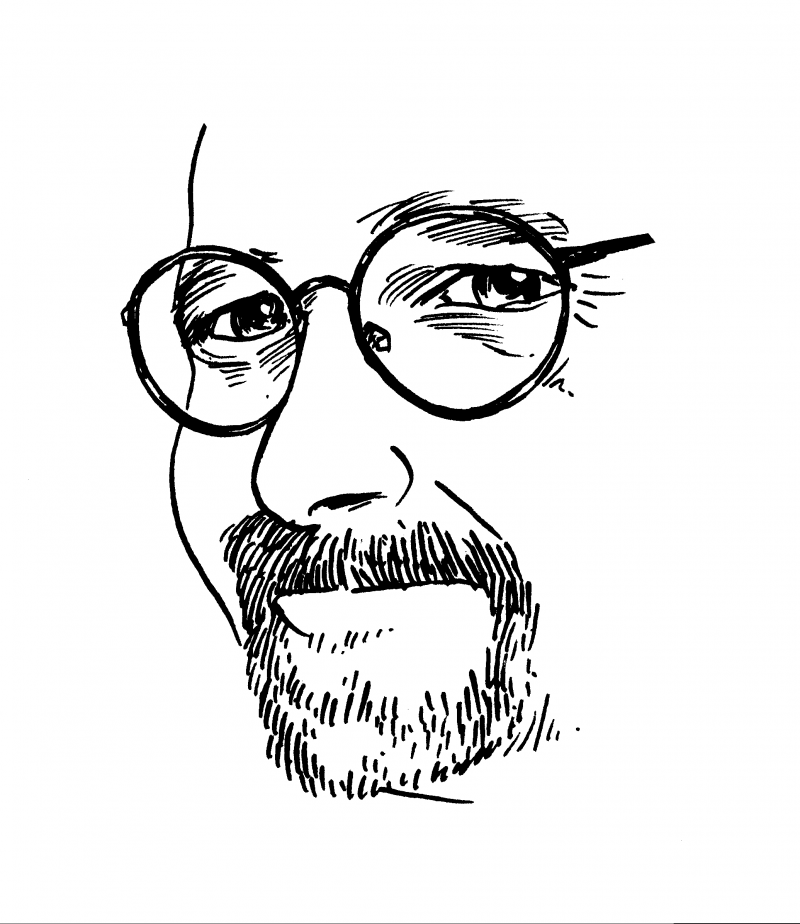During the nineteenth century, racist imagery in the popular press was as American as apple pie. A large helping of “benign” black, Jewish, Irish, Mexican, and Native American caricatures and stereotypes filled newspapers and magazines, adorned product packages and advertisements, and illustrated books. The old melting pot overflowed with comic characters that today are considered demeaning at best, downright disgusting at worst. But back when ethnic and racial differences were threatening, and the word consciousness was barely in the dictionary, appallingly crude ethnic stereotypes were the favored commercial trademarks and cartoon entertainments. In fact, many of these depictions—which some considered a right of immigrant passage—were thought to be “friendly,” as in a friendly mascot, or as they were known in the advertising industry, “trade characters.” Yet in addition to integrating these second- and third-class citizens into society as objects of humor, the constant barrage of distorted characterizations ghettoized entire peoples according to physical and linguistic traits. Eventually, by the mid-twentieth century, much (though not all) of this mass-media stereotyping ceased, but the cultural misconceptions continued.
Steven Heller, an art director for the New York Times for more than thirty years (as well as a prolific author, editor, publisher, curator, and lecturer) has long collected artifacts from this “golden age” of pictorial racism. The following pages contain selections from his collection, accompanied by a conversation with novelist Susan Choi about the images, their question of their relevance today, and Heller’s impulse for collecting them. Choi, a winner of the Asian American Literary Award and a finalist for the Pulitzer Prize, conducted the interview over email last fall.
–Susan Choi
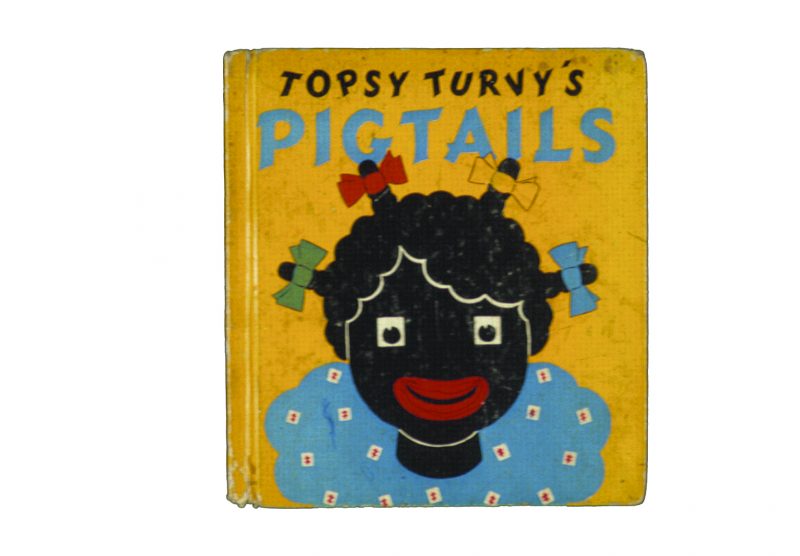
I. RACIALLY INSENSITIVE BARWARE
SUSAN CHOI: Let me begin by saying your collection is extraordinary.
STEVEN HELLER: Thank you. This is just a tiny sampling. What’s most fascinating is the volume of material involving “benign” racial and ethnic stereotypes used exclusively for popular art and advertising—I’m not talking malignantly racist material from supremacist groups, etc. Publishers and advertisers didn’t think twice about using imagery that would offend today, but back then it seemed as American as apple pie.
SC: How did the collection begin?
SH: It began when I was working on an exhibition of satiric art from the German magazine Simplicissimus. I noticed that among the beautifully produced and acerbically conceived anticlerical and anti-kaiser cartoons were certain matter-of-fact racial stereotypes (usually of blacks, but Jews and some Chinese were included). It made me wonder whether the U.S. had a similar comic vocabulary. Then I was introduced to a collection of “trade cards” that portrayed “Negroes” with big red lips and bulging eyes, and Jews with long hooked noses. I didn’t have to dig too much further. I found the material in all media—newspapers, magazines, on packages, in cartoons, in joke books, etc.—from the pre–Civil War period through the 1950s. And then there are all those old cookie jars and salt shakers, and let’s not forget the cast iron jockeys.
SC: Which of these was the first image you acquired?
SH: I don’t think the first one I ever acquired is included in this selection. But I remember as a kid thinking that those ads for Cream of Wheat and Armour Meats featuring black chefs were kind of odd. But in those days, at least in New York City, middle-class families had black maids and cooks as a matter of course.
SC: When you first started collecting these images, why did you feel you needed to have them?
SH: I had to have this material because it wasn’t chronicled elsewhere, at least when I started acquiring it. It was a cancerous part of history that was simply being ignored. People told me it was an old wound best left alone, lest it get infected all over again. But I felt it was so pervasive— and so American—that it had to be analyzed. I have to admit that with each acquisition I felt hungry for the next. There’s just so much variation on the theme, and some of it contextually complex. I soon realized that even the most sarcastic images were meant as good clean fun, even though I knew from hindsight that they perpetuated dangerous myths.
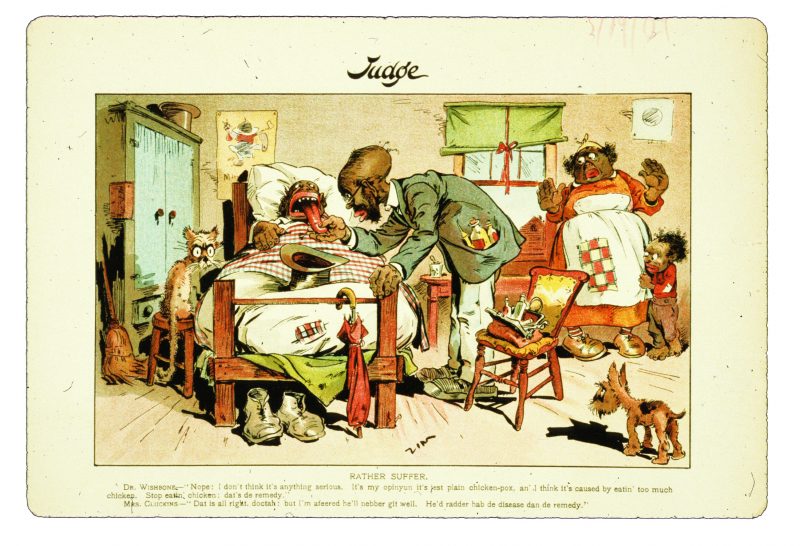
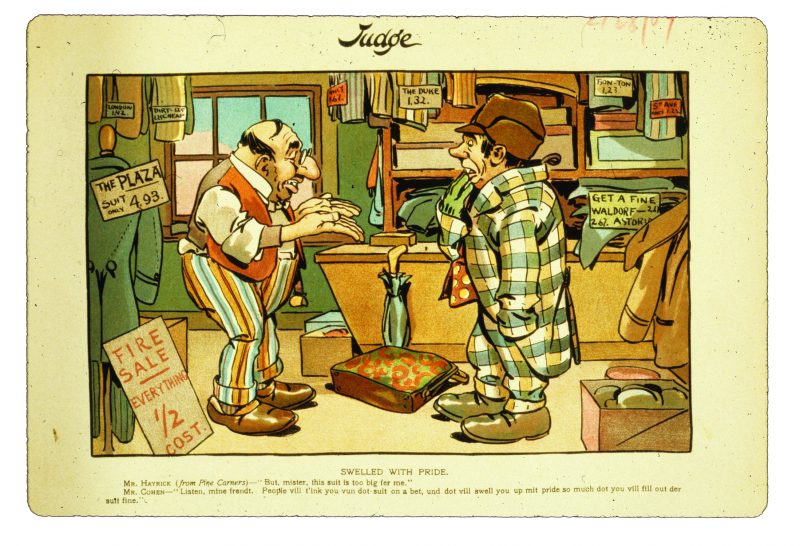
SC: I’ve always found images like this strangely compelling, and sometimes irresistible, myself. Though I’m no serious collector, I own several good examples of what I jokingly call “racially insensitive barware.” But I’ve also always felt that my interest in such images required some sort of bona fides: that it’s “OK” because I myself am “enlightened;” or because I’m a person of color, or both. I don’t know if these excuses are sufficient, or if excuses are even required. Do you feel that your collecting such images requires a justification? If so, what’s yours?
SH: I think we sensitive types are always in need of justification. Mine is that I want to expose this stuff to the world and make people aware of our dubious heritage. That said, there is a curious tactile pleasure from encountering this stuff. Some of it is curiously funny. Some of it is just so absurd it’s hard to take seriously. And some of it is the root of contemporary stereotypes. Stereotypes can be so goofy that we laugh at them without being offended. I continue to have the high-minded excuse that I’m creating a chronicle for scholarly interest. But I also collect because it’s odd in today’s context.
SC:Those old cookie jars, salt shakers, and cast iron jockeys you mention are more difficult to respond to, because they’re less obviously egregious. They came to mind for me recently when the New York Times ran an article in the business section about a new recurring character in television commercials, the “boisterous” two-hundred-pound black woman, whose size and sass are the punchline of every commercial she’s in. This makes a lot of people uncomfortable; they see a negative racial stereotype at work, in precisely the way in which we see it at work in your collection. Do you see a connection between the contemporary commercials being discussed there,and these old advertising images, which deploy stereotypes we like to think are no longer current?
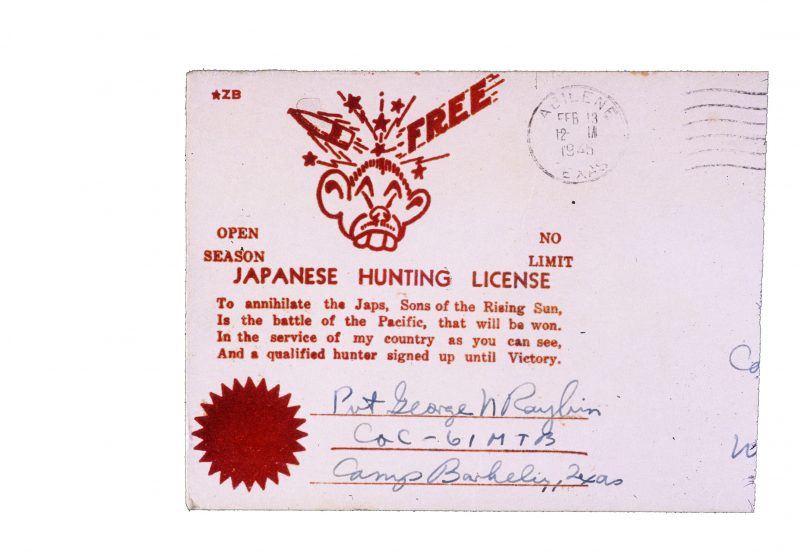
SH: I don’t view vintage advertising very differently from contemporary advertising. Techniques and media have changed, but the basic formulations haven’t. In the old ad industry, magazine stories analyzing trade characters were common. And the most common stories of all were those about black trade characters—like Aunt Jemima, Uncle Ben, and others now out of commission. They called them friendly, and claimed that housewives—since all these things were aimed at women—felt comfortable bringing them into their homes. The black ones were ideal house servants—friendly, accommodating, capable. I see very little difference between these print characters and their TV counterparts from the ’40s through today. The characterizations have changed: until the late ’60s, blacks never appeared in prime-time commercials unless they were servants; now there are black primary characters representing all different kinds of jobs and professions. But the intent of advertising is still to create either an identifiable role model or a memorable stereotypical character that exudes the essence of some product. I’ve only seen that “boisterous black woman” once, but it did recall the “mammy” character for me. I wasn’t shocked, but at the same time I understood this character; like 50 percent (at least) of all the other types on TV commercials are generalizations designed to elicit recognition on the part of the consumer. While this woman harkens back to the mammy, it also suggests other more contemporary blacksploitable types. In any case, the images in this collection are the foundation for images today—no question.
SC: It’s ironic because for me, part of the appeal of the images in your collection lies in their seeming outdatedness. I feel a sort of inverted nostalgia, both reproachful of and condescending toward our racist forebears. In other words, I like to imagine that we as a society have moved on, but this is a deluded idea; of course we haven’t moved on in any thorough sense, and perhaps we haven’t moved on at all. The “Jap Hunting License” in your collection exists today in almost the same form exactly, except for having been updated to permit hunting “terrorists”—read “turbaned Arabs.”The sheet music for “A Pale Face Pow Wow” reminds me of the controversy surrounding the name of the Washington Redskins football team. Let’s assume this: racist thinking and image-making is alive and well. What, then, are our responsibilities here, if any? Do we speak up, make these images problematic to others who don’t necessarily see them that way? Do we decline to consume products marketed with offensive racial stereotypes? Perhaps I’m being a bit of a Pollyanna, but given that we both find a lot of continuity between the images in your collection and those that surround us, the question interests me. For example, none of us are decorating our homes with funny pictures of big-nosed Jews, yet we’re watching the commercials with the “boisterous” black woman, and buying the products she hawks. Is there something hypocritical in our active condemnation of the old images, while we passively consume the new ones?
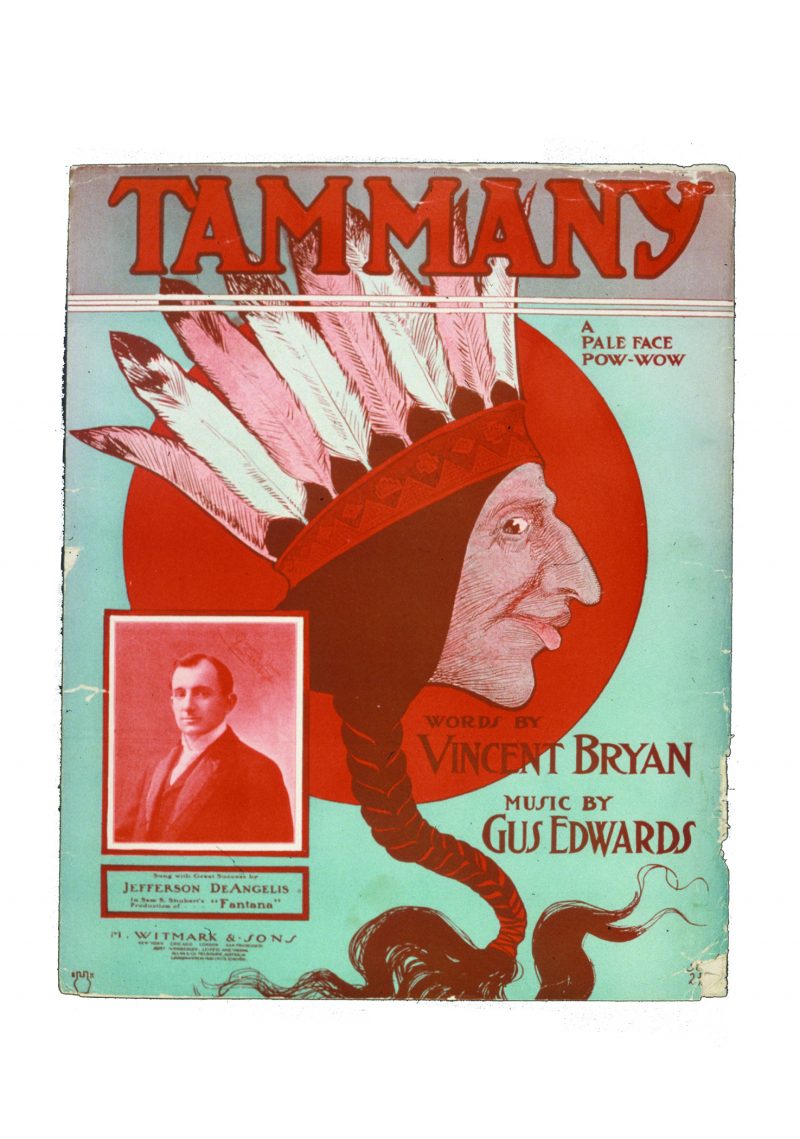
SH: I only wish we’d come a long way since the days when these vintage images were prevalent and acceptable. They’re only outdated in certain respects, and they continue to tickle some funny bones and lesser appendages. After all, racism is built into our country’s heritage—it’s written into parts of the Declaration of Independence and Constitution. All men are not created equal. If you have land, are white, and have balls, you have the vote. Otherwise, you take your knocks as a member of the exploited stereotype classes. But what about the Redskins? Native American images—generalized and stereotyped—have been exploited in our commercial culture for decades, and still are. The Redskins are singled out because “red skin” sounds pejorative. To the contrary, Land O’Lakes, Argo cornstarch, and various other products that use Native American representations are sanctioned in the same way Aunt Jemima is accepted. Do we call these racist? Racialist? Or simply American? I’d argue against my nature that many of the racist images in this collection made people aware of other races, perhaps in a distorted way but, as the advertisers insisted, often in a friendly way. So what are our responsibilities? I’d say: to keep the dialogue going. But rather than make these things completely taboo, we should question the use of racial and ethnic stereotypes. Maybe they aren’t altogether negative. Do we boycott those that are? I think the marketplace has a way of filtering out truly offensive material: remember “Darkie” toothpaste? It was sold by a major international home-care product company to Far Eastern countries (you can see a billboard for it in Full Metal Jacket). When Westerners saw the minstrel image and read the title, they were offended enough to petition the parent company, and they altered the brand name to “Darlie” and streamlined the minstrel trade character to look more nondescript. Still, if offensive imagery represents a product, we should choose not to be an accomplice. On the other hand, until someone definitively declares that certain representations are taboo, then I guess consensus will rule. If that “boisterous black woman” is offensive, then it’s time to say so en masse. I believe that advertisers will genetically test the limits of what’s appropriate—it’s in their nature to be safe, but as creatives it’s in their nature to push the envelope, too. If they feel they can get away with something, and think it’ll cause a positive buzz— guess what? They’ll do it. If no one complains about the boisterous black woman, or if the publicity helps rather than hinders the company, not only will they continue, but the “boisterous black woman” style will be hot. The hypocrisy is in believing that we’re different from our ancestors. I don’t think we are.
II. HAPPY, SEXLESS PEOPLE
SC: There’s this idea on the part of advertisers ancient and modern that racial images might be helpful in presenting “friendly” images of unknown others to the presumably white mainstream of consumers. It’s a hard notion for me to swallow, in large part because I don’t believe advertisers do anything for the good of society. So, if advertisers once thought that a warm-bosomed black mammy appealed to a certain class of white housewife by making that housewife feel safe via association with, perhaps, the black maid of her childhood, I can certainly understand why advertisers would exploit that association. But I would never buy the idea that advertisers were, in the abstract, interested in creating “friendly” racial stereotypes so as to educate and enlighten their inexperienced white consumers. Of course, you’re not saying advertisers actually sought to do this; only that they, perhaps, retrospectively justified questionable representations on such grounds.
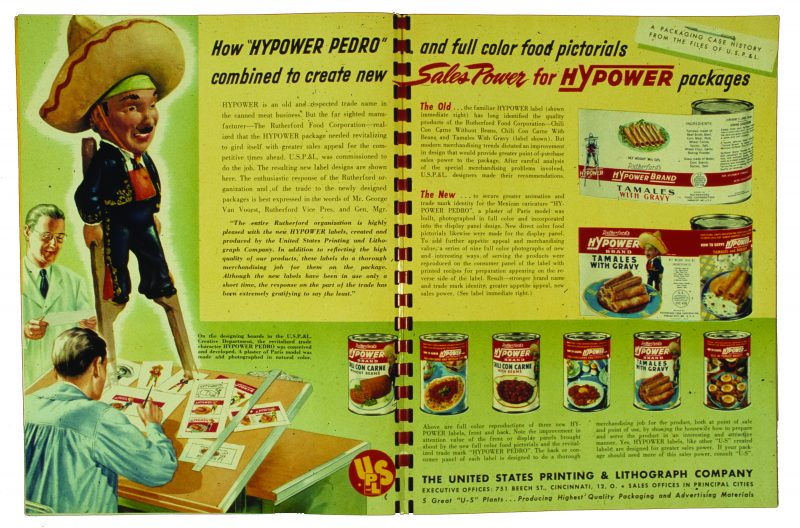
But for argument’s sake, let’s say there’s a “friendly” vein of racial representation—the Other is harmless, dopey, funny! It’s interesting, then, to contrast such images with those which overtly seek to dehumanize the Other. The two tendencies are at war with each other. One assumes we need to be reassured that the Other is a harmless pal; the opposing tendency seems to fear we’ll fall for the very same notion.The “Jap Hunting License” is a good example of the latter, as is Fu Manchu; both can be easily linked to contemporaneous world affairs, just as can be today’s “Terrorist Hunting License” and any number of film depictions of swarthy Arab villains. Neither category is worse, although, as we were discussing earlier, often the “friendly” depictions are more problematic, given that they are less glaringly egregious. The work they do is subtler. People often wonder why Asians dislike the “model minority” stereotype, given that it is positive; what’s wrong with having outsiders assume you’re nerdy, smart, timorous, financially successful, and law-abiding? Aren’t those positive traits, on the whole? But the very notion of an entire race sharing traits is in itself offensive, even if those traits are good. Minstrelsy once seemed like a fine and friendly depiction of a fine and friendly—and stupid, and inferior—group: black folk, eating watermelon wedges with their shiny white teeth.
I’m trying to envision some sort of formula that expresses the quantity of racially offensive ideology left over after the market—reflecting the tendencies and opinions of the mainstream, whoever they are—has “filtered” the really glaring stuff out. For example, Darkie toothpaste is no longer acceptable to an apparent majority. But there will always be a lag, as the concerns of less well-represented groups seek to make themselves felt. “Darkie” has been swept away by popular sentiment, but that same sentiment still condones the Land O’Lakes maiden, for example. This doesn’t mean that she’s just fine; whether or not a representation is offensive to a minority of people can’t be decided by majority vote. Then again, I doubt I’ll stop buying Land O’Lakes butter. Am I no better than those consumers who once happily brushed with Darkie?
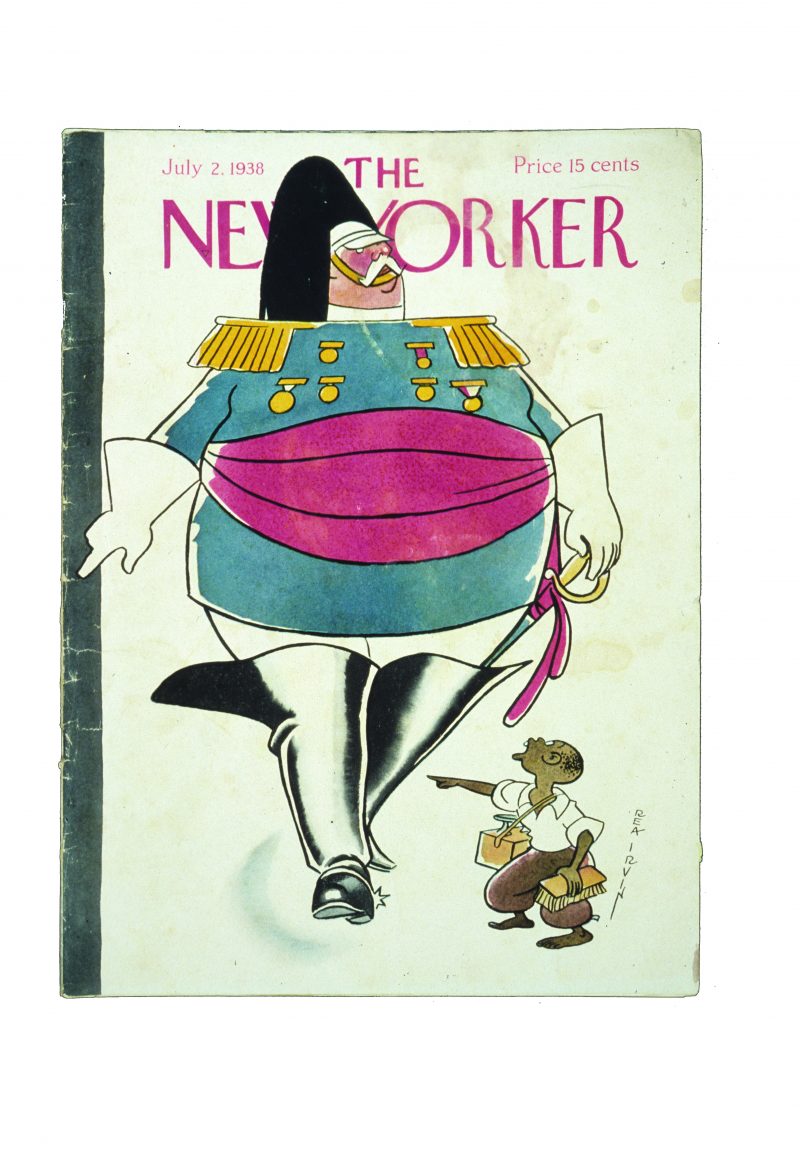 SH: I’m not suggesting that advertisers were doing anything for the benefit of humankind. To the contrary, everything they did then, as now, was exploiting emotional responses for the purpose of branding an idea and a product into malleable minds. No illusions here. I am, however, saying that “friendly” is a virtue for advertisers, and that “friendly characters” were emotionally compatible with perceived audiences of voracious consumers. Moreover, trade characters were developed to separate one product from the next, when little else distinguished them. So the “friendlier” or “funnier” the character, the better to do such a thing.These were produced before there was market testing of the kind and magnitude we see today. But it was the nascent period of ad-ology, the early days of propaganda, which Edward Bernays, Freud’s nephew, claimed was “informing” the public and therefore was good for the public—in some twisted way—because they were made aware of America’s bounty.
SH: I’m not suggesting that advertisers were doing anything for the benefit of humankind. To the contrary, everything they did then, as now, was exploiting emotional responses for the purpose of branding an idea and a product into malleable minds. No illusions here. I am, however, saying that “friendly” is a virtue for advertisers, and that “friendly characters” were emotionally compatible with perceived audiences of voracious consumers. Moreover, trade characters were developed to separate one product from the next, when little else distinguished them. So the “friendlier” or “funnier” the character, the better to do such a thing.These were produced before there was market testing of the kind and magnitude we see today. But it was the nascent period of ad-ology, the early days of propaganda, which Edward Bernays, Freud’s nephew, claimed was “informing” the public and therefore was good for the public—in some twisted way—because they were made aware of America’s bounty.
Bernays was also the man who convinced Lorillard to distribute free cigarettes to suffragettes so that they would smoke during their marches, leaving the impression that they were liberated, but also defining an entirely new market for smokers.The idea that this was good for women was couched in the marketing cynicism of the day. And so, using racial stereotypes to express Otherness in a positive light was also highly suspicious, and a decidedly cynical manipulation of people’s good—and bad—will. And even these friendly characters, be they mammys or Pullman porters, are generalized, simplified, and ultimately denigrating caricatures. They may not be as nasty as hate-based racist imagery, but they had long-term effects because they marked these individuals with a scarlet letter on a mainstream stage.
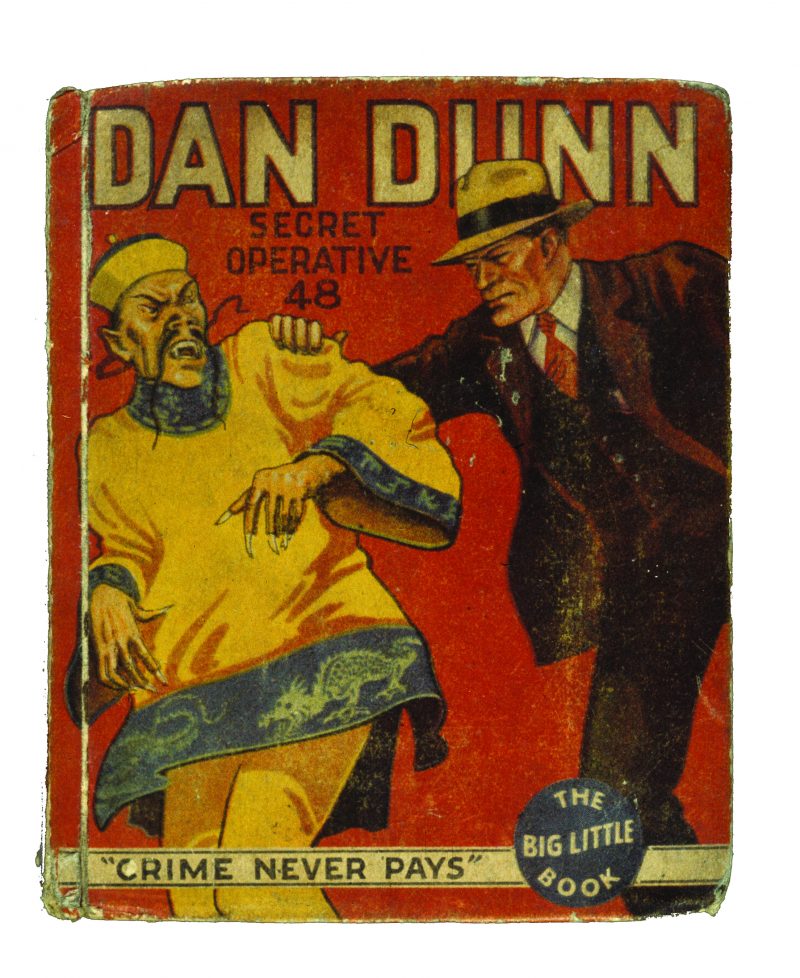 Interestingly, the Asian stereotypes—mostly Chinese around the turn of the century and up until World War II—were decidedly more onerous than the black or Indian “friendly trade characters.” Chinese were not wanted on these shores—particularly peasant or coolie Chinese.There are many depictions of them with sinister-looking “rat tails” in advertisements and trade cards. Almost all of the depictions are male because there was very little female immigration at this time. And most were depicted as washer-men. I have seen a startling ad image of “Chinamen” being kicked into the Pacific Ocean by Uncle Sam, who’s in cahoots with a washing machine (the tagline reads: “Now we don’t need them anymore”). So the idea of “friendly” is relative. Blacks and Indians were often presented as more “friendly” if they satisfied a commercial need, but nonetheless in all cases they represented the servant class.This servant class changes every generation or so. There’s the episode of Curb Your Enthusiasm where Larry David buys his Mexican maid a bra because his goyish wife finds her sagging breasts offensive, which in turn offends David’s gardener, the body-tattooed husband of the maid. It’s perpetuating the “friendly” character for the twenty-first century. But I understand why you would still buy Land O’Lakes. By virtue of its longevity in a highly racially sensitized world, it seems sanctioned. It’s like accepting “cartoon violence” in movies or video games; it may be violence, but it’s made somewhat laughable by virtue of its absurdity. The Land O’Lakes mascot may be a squaw bowing to white men, but she’s a pretty squaw who appears to have no real ethnicity. Reduced of all her Indian-ness, except for the costume, she’s palatable as a trademark, no more offensive, perhaps, than the Pillsbury Doughboy. Moreover, it’s a product “you’ve come to trust,” as the advertising flaks say. So it’s easy to turn a blind eye to more sensitive issues. I wonder whether I’d buy it if it depicted a Hasidic man or, worse, a Hasidic woman with a wig. I’ll say this: There are certain Jewish ethnic stereotypes I would buy, simply for the irony. If there was Uncle Moishe’s rice, I might buy into it, because it’s curiously witty. Would you buy into anything that others might find offensive?
Interestingly, the Asian stereotypes—mostly Chinese around the turn of the century and up until World War II—were decidedly more onerous than the black or Indian “friendly trade characters.” Chinese were not wanted on these shores—particularly peasant or coolie Chinese.There are many depictions of them with sinister-looking “rat tails” in advertisements and trade cards. Almost all of the depictions are male because there was very little female immigration at this time. And most were depicted as washer-men. I have seen a startling ad image of “Chinamen” being kicked into the Pacific Ocean by Uncle Sam, who’s in cahoots with a washing machine (the tagline reads: “Now we don’t need them anymore”). So the idea of “friendly” is relative. Blacks and Indians were often presented as more “friendly” if they satisfied a commercial need, but nonetheless in all cases they represented the servant class.This servant class changes every generation or so. There’s the episode of Curb Your Enthusiasm where Larry David buys his Mexican maid a bra because his goyish wife finds her sagging breasts offensive, which in turn offends David’s gardener, the body-tattooed husband of the maid. It’s perpetuating the “friendly” character for the twenty-first century. But I understand why you would still buy Land O’Lakes. By virtue of its longevity in a highly racially sensitized world, it seems sanctioned. It’s like accepting “cartoon violence” in movies or video games; it may be violence, but it’s made somewhat laughable by virtue of its absurdity. The Land O’Lakes mascot may be a squaw bowing to white men, but she’s a pretty squaw who appears to have no real ethnicity. Reduced of all her Indian-ness, except for the costume, she’s palatable as a trademark, no more offensive, perhaps, than the Pillsbury Doughboy. Moreover, it’s a product “you’ve come to trust,” as the advertising flaks say. So it’s easy to turn a blind eye to more sensitive issues. I wonder whether I’d buy it if it depicted a Hasidic man or, worse, a Hasidic woman with a wig. I’ll say this: There are certain Jewish ethnic stereotypes I would buy, simply for the irony. If there was Uncle Moishe’s rice, I might buy into it, because it’s curiously witty. Would you buy into anything that others might find offensive?
SC: There must be a good example of an offensive product I buy for the irony of it, because I indulge that slightly wicked streak, too. But I can’t think of anything. Is there no Gook brand soy sauce or Coolieman laundry starch that I own? Just as you report a sort of exaggerated interest in negative Jewish images, my radar is most attuned to negative Asian images, although I’m also Jewish. Many of the Asian images that interest me were not, in their time, intended to be denigrating in the least, but from a modern perspective they’re condescending and exoticizing. I have a slim children’s book from the ’50s—Korean War–era—called Kim of Korea, about a little Korean boy and his fascinating land. Depictions of Asians outside the advertising you mention throughout the twentieth century often seem to fall into the South Pacific category: happy, sexless people who do delicate dances with flowers. It’s amazing how such notions can coexist with the nefarious rat-tailed “coolie.” I’ve already confessed my interest in racially insensitive barware. I really own only a few such items, but that I own any is a testament to their ubiquity, because I’ve picked them up at yard sales I wandered across rather than searching them out.They fall into two categories: mischievous “darky” cannibals, dancing gleefully whilst boiling white victims; and liquor-addicted Injuns who just can’t say no to that firewater.Why have I found myself unable to resist these objects? They give me a sort of thrill of horror. And it’s always amazing to see them there, benignly for sale amid the rest of somebody’s mundane household junk.
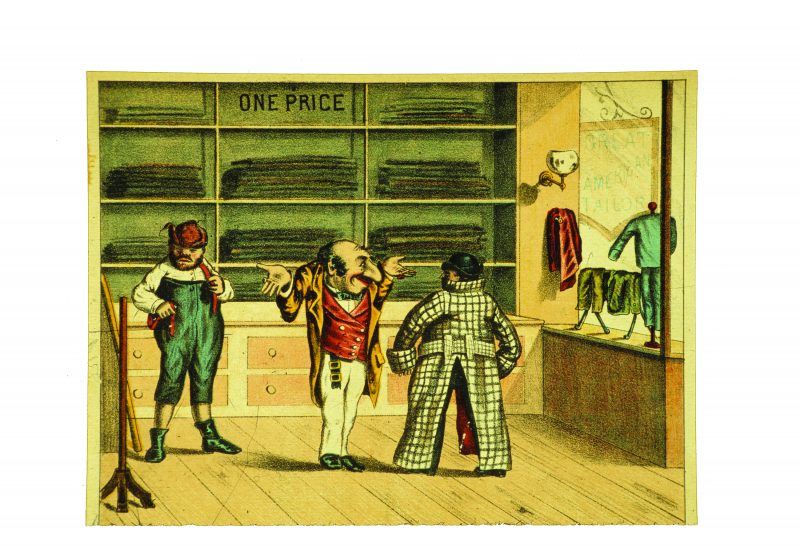
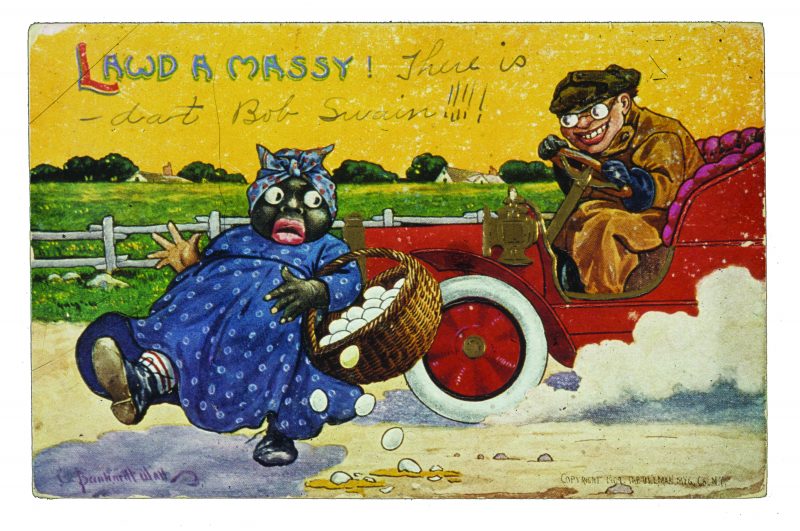
III. “DEM GOOD OLE DAYS”
SC: We’ve talked a lot about advertising, but not about the impulses underlying the manufacture of, and possession of, these everyday household items which incorporate a racialist image as easily as they might incorporate a floral border.What desire do such objects meet? What, for example, was the function of the novelty postcard in your collection captioned “We’re Safe”? A few years ago, I saw a great piece of art at the MASS MoCA, in North Adams. A photographer had taken items from the collection of the Society for the Preservation of New England Antiquities and, photographing them, had turned the images into postcards that were for sale for a quarter or so each. I bought a pile of them. I’m looking at two now: one is of an embroidered fire screen, done lovingly in needlepoint. The pattern includes a swan, a key, hearts, flowers, and other domestic objects—including two little darkskinned figures holding hands and dancing; below them appear the words We’s free. Did this fire screen belong to a proud abolitionist, perhaps? My other postcard reproduces an 1848 portrait of a child. The plump child is holding a lesson book open and if you look closely, you can see the two images the lesson book is teaching. On the left, a silhouette of a cat, captioned CAT. On the right, a silhouette of a human figure with a hobo’s bundle over one shoulder, captioned DARKEY.
SH: Why people would buy or display a novelty or even a serious piece of pottery with racialist imagery can only be analyzed in context. Thirty or forty years ago it was OK to have a black jockey on your lawn or mammy and pappy salt shakers. They were quaint, but they were also “folksy.” Who knew that under every jockey was decades of persecution? Who could have imagined that such a positive image as mammy was the desexualized and exploited shadow of the antebellum South? Or worse, since (officially) there are no more slaves, who could have thought that nostalgia for “dem good ole days” was offensive to anyone? After all, advertisers presented them as “friendly trade characters.” But I also think there is a more insidious reason for owning such objects, and the sense of condescension isn’t so subtle.“Them’s may not be’s slaves, but them’s de servants”—even if only cast in lead or molded in plastic. The masses may sometimes act like sheep, but choices are made for a reason. And I believe a big reason why benign (if you can call them that) racial stereotypes exist is to make the perpetrators feel safely superior in the face of otherness. Owning these things is not a political statement. It’s not truly about irony and busting taboos. It’s about feeling some sort of kinship, whatever that may be.

